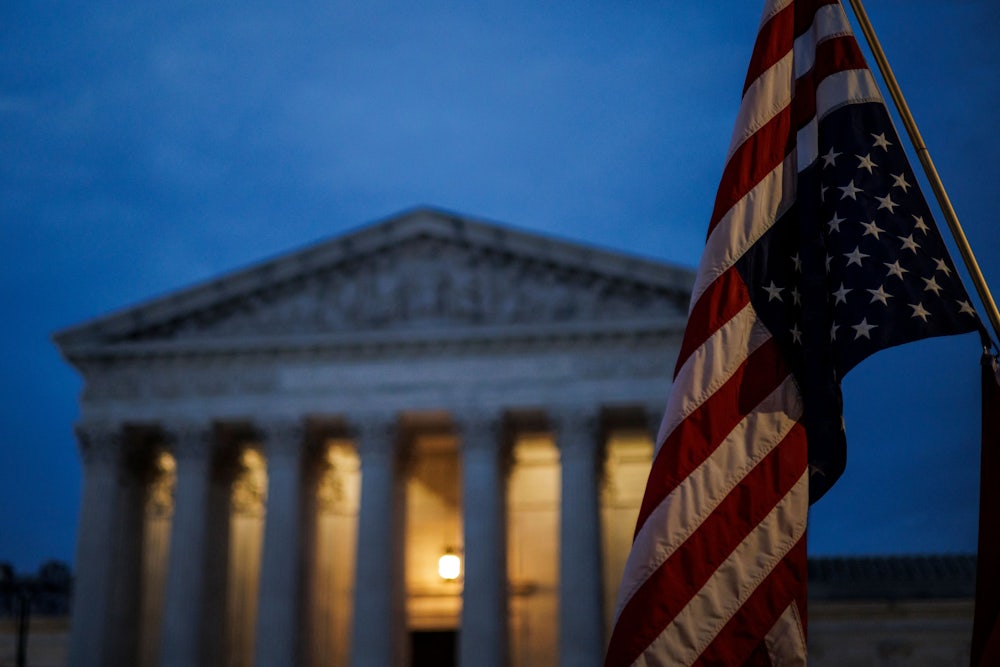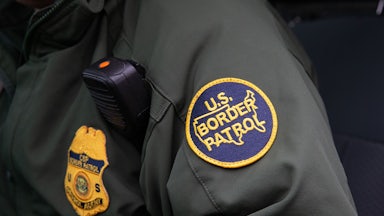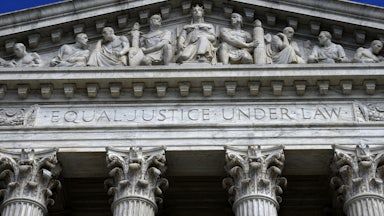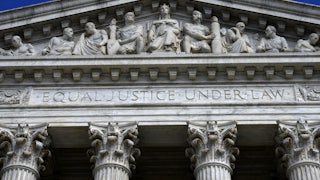Running an American election is complicated work. Ballots are cast in tens of thousands of precincts, counted in thousands of county offices, and certified by each of the 50 states. In 2016, the last presidential election held before the Covid-19 pandemic, there were more than 116,000 polling places and early voting sites scattered throughout the country. Roughly 917,000 Americans served as poll workers that year, forming an army roughly two and a half times larger than the Allied forces that carried out the Normandy landings on D-Day in 1944.
Who decides how this massive, byzantine process should be carried out? The Constitution spells out how federal elections should be run: A clause in Article I says that “times, places and manner of holding elections for senators and representatives shall be prescribed in each state by the legislature thereof,” then adds that Congress “may at any time by law make or alter such regulations.” In other words, federal election rules are generally written by the states but can be superseded by Congress if it wishes. (Similar language exists in Article II for the presidential elections, but we’ll come back to that later.)
For most of the republic’s history, people generally assumed that “prescribed in each state by the legislature thereof” meant that the states write the rules through their normal legislative process. A lawmaker drafts a bill, the legislative body approves it, the governor signs it, and the state courts interpret it. But a new idea that’s come back in vogue among conservative legal theorists, known as the “independent state legislature theory,” or ISL theory, takes a different view of things. Its proponents argue that the language of the Elections Clause should be read hyper-narrowly to mean that “the [state] legislature thereof” has the exclusive power to set election rules. The Supreme Court will decide who is right in Moore v. Harper later this fall.
The case revolves around a dispute over congressional districts drawn last year in North Carolina. The state’s legislature drew new districts based on the 2020 census that gave Republicans a 10–4 advantage over Democrats in congressional races. Voters and voting rights activists filed multiple lawsuits alleging that the new maps amounted to partisan and racial gerrymandering. The North Carolina Supreme Court largely agreed with them and ordered the maps redrawn by the lower courts.
Earlier this year, the U.S. Supreme Court declined to block the revised maps from going into effect for the 2022 election, apparently because it was too close to the election deadlines to restart the process. In June, however, the justices agreed to hear the case and decide whether the North Carolina courts could lawfully and constitutionally order the maps redrawn under the Elections Clause.
Some of the high court’s conservatives made their views clear on the ISL theory at the earlier stage in litigation. “This [Elections] Clause could have said that these rules are to be prescribed ‘by each State,’ which would have left it up to each State to decide which branch, component, or officer of the state government should exercise that power, as States are generally free to allocate state power as they choose,” Justice Samuel Alito wrote in a dissenting opinion on whether to stay the lower court’s judgment in Moore. “But that is not what the Elections Clause says. Its language specifies a particular organ of a state government, and we must take that language seriously.”
The biggest hurdle for ISL proponents, however, is that the Supreme Court has never endorsed the theory and all but explicitly rejected it in 2015. In Arizona State Legislature v. Arizona Independent Redistricting Commission, a group of state lawmakers in Arizona tried to overturn a state ballot initiative that sought to curb gerrymandering by transferring redistricting power to an independent commission. Shifting that authority over an election-related rule to a nonlegislative body, they argued, violated the Elections Clause.
Justice Ruth Bader Ginsburg, writing for a 5–4 majority, rejected that interpretation. She wrote that the court had long interpreted “legislature” to mean the state’s legislative process as a whole, not just the legislature itself, and that the Arizona state Constitution expressly allowed laws to be passed not only by the legislature but also by the voters themselves through ballot questions. Chief Justice John Roberts wrote in dissent that the majority’s ruling “has no basis in the text, structure, or history of the Constitution, and it contradicts precedents from both Congress and this Court.”
Since that ruling seven years ago, the court’s composition has significantly changed. Three of the four dissenting justices—Roberts, Justice Clarence Thomas, and Alito—are still on the court. The seat held by the fourth dissenter, Antonin Scalia, is now held by Justice Neil Gorsuch, who has himself written opinions that suggest he would favor the theory. And two of the justices in the Arizona majority, Anthony Kennedy and Ginsburg, have been replaced with justices who are slightly and greatly more conservative than they were.
Justice Amy Coney Barrett has not yet written on the Elections Clause since joining the court. But Justice Brett Kavanaugh has signaled in recent election cases that he favors reinterpreting it. He joined a concurring opinion by Gorsuch in 2020 that voiced support for the ISL theory in a dispute over Wisconsin’s courts, Covid restrictions, and early voting. “Nothing in our founding document contemplates the kind of judicial intervention that took place here, nor is there precedent for it in 230 years of this Court’s decisions,” Gorsuch claimed. And Kavanaugh parted ways with Alito on blocking the lower court ruling in Moore because he thought it was too close to the primary elections to feasibly redraw any districts, not necessarily because he disagreed with his reading of the Elections Clause.
Why does it matter whether the Elections Clause meant one thing or something else? Rick Hasen, a UCLA law professor who specializes in election law, noted in Slate recently that the ISL theory comes in two flavors. Even in its mildest form, he noted, reinterpreting the Elections Clause in this way could make it significantly harder, if not impossible, for state courts to review gerrymandering claims when states redraw legislative maps. Since the Supreme Court closed off the federal courts to partisan-gerrymandering cases in 2020, that would leave Section 2 of the Voting Rights Act as the only feasible mechanism for some types of anti-gerrymandering cases—and the Supreme Court is already hearing a case that could narrow Section 2 next term.
A more radical version of the ISL theory could open the door to outright subversion of election results. “How so?” Hasen explained. “Suppose a state court or agency interprets state rules to allow for the counting of certain ballots, and doing so favors one candidate. If the leaders of the legislature are from the other party, and they say that the interpretation does not follow the views of the legislature, it’s impermissible and the results need to flip.” Former President Donald Trump and his allies sought to do just that after the 2020 election when they urged Republican state lawmakers to throw out the results in states where Biden had won. It’s far from certain that the courts would allow this under other legal doctrines, Hasen noted, but it might not stop a malevolent candidate and state legislature from trying.
Another problem for the North Carolina lawmakers—and for the Supreme Court justices who are ready to constitutionalize the ISL theory—is how North Carolina’s election laws are currently written. In its brief urging the Supreme Court not to review the decision, North Carolina noted that the state election laws in question explicitly allow for judicial review during the redistricting process.
“In characterizing the state courts as ‘usurp[ers],’ [the legislators] elide a key fact: the state courts’ actions in this case were part of a redistricting-review process that the North Carolina legislature itself designed and codified in statutes,” the state told the court. “The legislature’s prescribed process directs actions challenging congressional redistricting plans to ‘three-judge panel[s] of the Superior Court of Wake County.’ As part of that process, the legislature expressly included court review of redistricting plans for constitutionality.” In other words, even if the ISL theory held true here, it wouldn’t necessarily change how things unfolded because the state legislature had consciously invited the courts into the process.
If the Supreme Court’s most recent term made anything clear, however, it’s that minor hurdles might not be enough to stand between the justices and their preferred outcomes. In Dobbs v. Jackson Women’s Health Organization, the court agreed to hear an abortion-ban case on narrow grounds when there was a 5–4 ideological split, then used the opportunity to overturn Roe v. Wade in June, after Barrett was confirmed to the high court. What matters now more than ever is whether there are five votes on the Supreme Court to do something—and the ISL proponents have good reason to think they have them.










